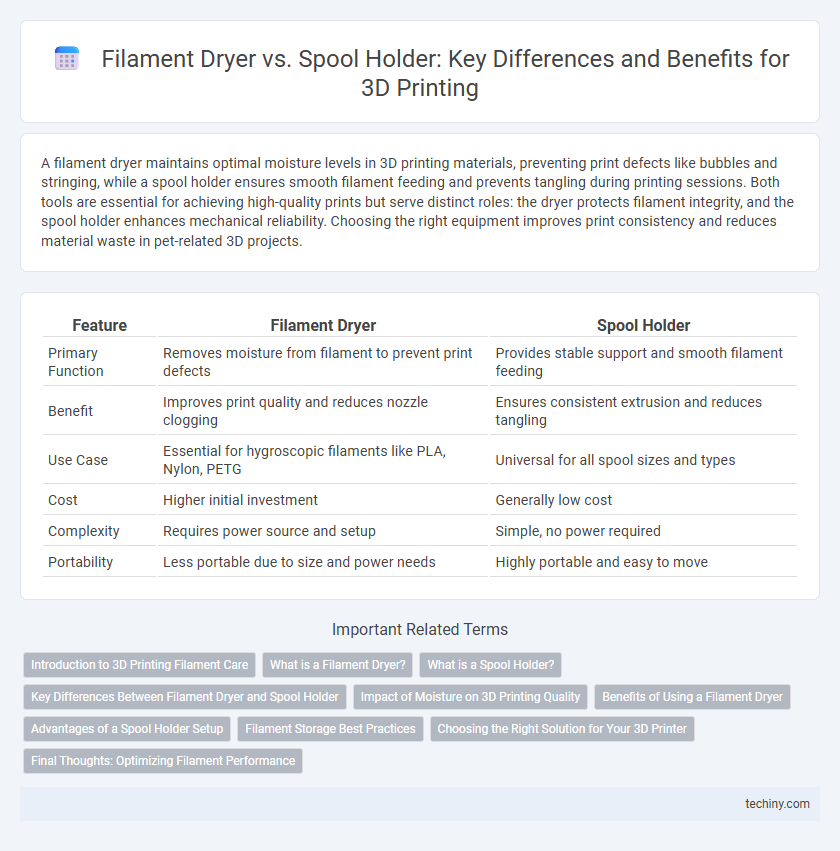A filament dryer maintains optimal moisture levels in 3D printing materials, preventing print defects like bubbles and stringing, while a spool holder ensures smooth filament feeding and prevents tangling during printing sessions. Both tools are essential for achieving high-quality prints but serve distinct roles: the dryer protects filament integrity, and the spool holder enhances mechanical reliability. Choosing the right equipment improves print consistency and reduces material waste in pet-related 3D projects.
Table of Comparison
| Feature | Filament Dryer | Spool Holder |
|---|---|---|
| Primary Function | Removes moisture from filament to prevent print defects | Provides stable support and smooth filament feeding |
| Benefit | Improves print quality and reduces nozzle clogging | Ensures consistent extrusion and reduces tangling |
| Use Case | Essential for hygroscopic filaments like PLA, Nylon, PETG | Universal for all spool sizes and types |
| Cost | Higher initial investment | Generally low cost |
| Complexity | Requires power source and setup | Simple, no power required |
| Portability | Less portable due to size and power needs | Highly portable and easy to move |
Introduction to 3D Printing Filament Care
Proper 3D printing filament care is essential for achieving high-quality prints and preventing issues such as moisture absorption, which causes filament brittleness and print defects. A filament dryer actively removes humidity from the filament, ensuring consistent extrusion and dimensional accuracy, while a spool holder provides stable filament feeding, reducing tangles and maintaining smooth printer operation. Combining both tools optimizes filament performance by maintaining dryness and ensuring proper filament tension throughout the printing process.
What is a Filament Dryer?
A filament dryer is a specialized device designed to remove moisture from 3D printing filaments, ensuring optimal print quality and preventing issues like bubbling or poor layer adhesion. Unlike a spool holder, which primarily supports and organizes the filament spool during printing, a filament dryer actively reduces humidity to maintain the filament's integrity. Using a filament dryer is essential for materials prone to absorbing moisture, such as PLA, PETG, and nylon, enhancing the overall reliability and finish of 3D printed objects.
What is a Spool Holder?
A spool holder is a device designed to securely hold filament spools during 3D printing, ensuring smooth and consistent filament feeding to the printer. It prevents tangling and provides stable rotation, which minimizes printing errors caused by uneven tension. Compared to a filament dryer, a spool holder does not affect filament moisture but enhances the mechanical stability of the printing process.
Key Differences Between Filament Dryer and Spool Holder
Filament dryers actively remove moisture from 3D printing filament, preventing print defects such as stringing and poor layer adhesion, while spool holders primarily provide physical support and smooth rotation of the filament spool during printing. Filament dryers often feature temperature control to maintain optimal drying conditions, whereas spool holders typically lack electronic components and focus on stability and ease of filament feeding. Understanding these functional differences is crucial for improving print quality and ensuring consistent filament performance.
Impact of Moisture on 3D Printing Quality
Moisture absorption in 3D printing filaments significantly degrades print quality by causing issues like stringing, bubbling, and poor layer adhesion. Using a filament dryer effectively removes moisture, maintaining optimal filament properties and ensuring consistent extrusion. In contrast, a spool holder primarily supports filament feed but does not address moisture, making a filament dryer essential for high-quality, accurate prints.
Benefits of Using a Filament Dryer
Using a filament dryer prevents moisture absorption, which significantly improves print quality by reducing stringing, bubbling, and layer adhesion issues. It extends the filament's lifespan and ensures consistent extrusion, minimizing failed prints and material waste. Filament dryers also maintain optimal filament performance across various humidity conditions, crucial for reliable and precise 3D printing results.
Advantages of a Spool Holder Setup
A spool holder setup enhances 3D printing efficiency by ensuring smooth filament feed, reducing tension and preventing tangling, which leads to consistent extrusion and better print quality. It also offers easy filament management, allowing quick spool changes and minimizing downtime during prints. Compared to filament dryers, spool holders require less maintenance and provide immediate operational benefits without additional energy consumption.
Filament Storage Best Practices
Maintaining optimal filament moisture levels is crucial for high-quality 3D printing, making filament dryers an essential tool for effective filament storage. Unlike spool holders that primarily organize filament, filament dryers actively remove absorbed moisture, preventing print defects such as stringing and poor layer adhesion. Proper filament storage combines airtight containers with humidity control and filament drying to ensure consistent print performance and material longevity.
Choosing the Right Solution for Your 3D Printer
Selecting between a filament dryer and a spool holder depends on your 3D printing needs and environment. Filament dryers remove moisture from filaments like PLA, ABS, and PETG, preventing print defects such as bubbles or stringing, while spool holders provide smooth filament feeding and reduce mechanical resistance during printing. Prioritize a filament dryer in high-humidity environments and a spool holder for enhanced spool management and consistent extrusion.
Final Thoughts: Optimizing Filament Performance
Maximizing filament performance in 3D printing hinges on minimizing moisture absorption and ensuring smooth filament feeding. A filament dryer effectively removes moisture that causes print defects like bubbles and weak layer adhesion, while a spool holder maintains consistent tension and prevents filament tangling that disrupts extrusion. Combining high-quality filament drying with a reliable spool holder optimizes print reliability and surface finish quality.
Filament Dryer vs Spool Holder Infographic

 techiny.com
techiny.com